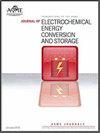Investigation of Gradient Platinum-Loading and Porosity Distribution for Anion Exchange Membrane Fuel Cells
IF 1.9
4区 工程技术
Q3 ELECTROCHEMISTRY
Journal of Electrochemical Energy Conversion and Storage
Pub Date : 2022-10-20
DOI:10.1115/1.4056029
引用次数: 0
Abstract
Anion exchange membrane fuel cells (AEMFCs) are in development as a low-cost alternative to proton exchange membrane fuel cells (PEMFCs). AEMFCs produce water at the anode side and consume it at the cathode side, resulting in no cathode water-flooding like in PEMFCS. However, it brings complexity to water transportation behaviour and requires appropriate water balance to avoid membrane drying out. In this study, a two-dimensional two-phase multi-physics model has been developed to investigate the impacts of three key electrode parameters (porosity, catalyst loading, and ionomer content) that are responsible for water production and transport as well as the performance of an AEMFC. A piecewise constant function along the x-direction (reactant diffusion direction) is used to apply the gradient on the porosity and platinum loading. The present results show that a larger porosity gradient near the cathode gas-diffusion layer (GDL)/flow-channel interface and lower near the GDL/microporous layer (MPL) interface can enhance mass transport and water removal, which is benefited the AEMFC performance. However, anode GDL porosity gradients show a lower AEMFC performance compared to the cathode porosity gradients. Moreover, it was confirmed that for both electrodes, the performance of AEMFC was significantly dependent on each electrode parameter.阴离子交换膜燃料电池梯度铂负载及孔隙分布研究
阴离子交换膜燃料电池(aemfc)作为质子交换膜燃料电池(pemfc)的低成本替代品正在发展中。aemfc在阳极侧产生水,并在阴极侧消耗水,因此不会像PEMFCS那样产生阴极水淹。然而,它给水的输送行为带来了复杂性,需要适当的水平衡来避免膜的干燥。在这项研究中,开发了一个二维两相多物理模型来研究三个关键电极参数(孔隙率、催化剂负载和离聚物含量)对水的产生和输送以及AEMFC性能的影响。沿着x方向(反应物扩散方向)的分段常数函数用于对孔隙率和铂载荷施加梯度。研究结果表明,阴极气扩散层(GDL)/流道界面附近孔隙度梯度越大,GDL/微孔层(MPL)界面附近孔隙度梯度越小,有利于AEMFC的传质和脱水,有利于AEMFC的性能。然而,与阴极孔隙度梯度相比,阳极GDL孔隙度梯度显示出较低的AEMFC性能。此外,还证实了对于两种电极,AEMFC的性能显著依赖于每个电极参数。
本文章由计算机程序翻译,如有差异,请以英文原文为准。
求助全文
约1分钟内获得全文
求助全文
来源期刊

Journal of Electrochemical Energy Conversion and Storage
Engineering-Mechanics of Materials
CiteScore
4.90
自引率
4.00%
发文量
69
期刊介绍:
The Journal of Electrochemical Energy Conversion and Storage focuses on processes, components, devices and systems that store and convert electrical and chemical energy. This journal publishes peer-reviewed archival scholarly articles, research papers, technical briefs, review articles, perspective articles, and special volumes. Specific areas of interest include electrochemical engineering, electrocatalysis, novel materials, analysis and design of components, devices, and systems, balance of plant, novel numerical and analytical simulations, advanced materials characterization, innovative material synthesis and manufacturing methods, thermal management, reliability, durability, and damage tolerance.
 求助内容:
求助内容: 应助结果提醒方式:
应助结果提醒方式:


